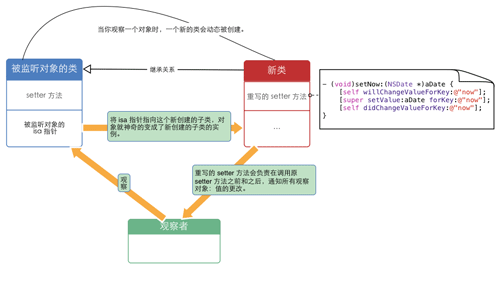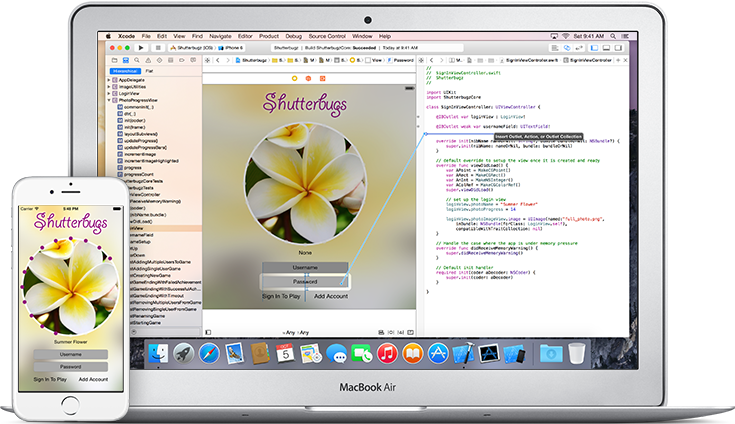KVC KVO高階應用
本文為投稿文章,作者:Zhiyi(博客)
KVC, KVO作為一種魔法貫穿日常Cocoa開發,筆者原先是准備寫一篇對其的全面總結,可網絡上對其的表面介紹已經夠多了,除去基本層面的使用,筆者跟大家談下平常在網絡上沒有提及的KVC, KVO進階知識。旨在分享交流。
目錄:
KVC的消息傳遞
KVC容器操作
KVC與容器類(集合代理對象)
KVO和容器類
KVO的實現原理
KVC的消息傳遞
valueForKey:的使用並不僅僅用來取值那麼簡單,還有很多特殊的用法,集合類也覆蓋了這個方法,通過調用valueForKey:給容器中每一個對象發送操作消息,並且結果會被保存在一個新的容器中返回,這樣我們能很方便地利用一個容器對象創建另一個容器對象。另外,valueForKeyPath:還能實現多個消息的傳遞。一個例子:
NSArray *array = [NSArray arrayWithObject:@"10.11", @"20.22", nil]; NSArray *resultArray = [array valueForKeyPath:@"doubleValue.intValue"]; NSLog(@"%@", resultArray); //打印結果 ( 10, 20 )
KVC容器操作
容器不僅僅能使用KVC方法實現對容器成員傳遞普通的操作消息,KVC還定義了特殊的一些常用操作,使用valueForKeyPath:結合操作符來使用,所定義的keyPath格式入下圖所示

Left key path:如果有,則代表需要操作的對象路徑(相對於調用者)
Collection operator:以"@"開頭的操作符
Right key path:指定被操作的屬性
常規操作符:
@avg、@count、@max、@min、@sum
對象操作符:
@distinctUnionOfObjects、@unionOfObjects
NSArray *values = [object valueForKeyPath:@"@unionOfObjects.value"];
@distinctUnionOfObjects操作符返回被操作對象指定屬性的集合並做去重操作,而@unionOfObjects則允許重復。如果其中任何涉及的對象為nil,則拋出異常。
Array和Set操作符:
Array和Set操作符操作對象是嵌套型的集合對象
@distinctUnionOfArrays、@unionOfArrays
NSArray *values = [arrayOfobjectsArrays valueForKeyPath:@"@distinctUnionOfArrays.value"];
同樣的,返回被操作集合下的集合中的對象的指定屬性的集合,並且做去重操作,而@unionOfObjects則允許重復。如果其中任何涉及的對象為nil,則拋出異常。
@distinctUnionOfSets
NSSet *values = [setOfobjectsSets valueForKeyPath:@"@distinctUnionOfSets.value"];
返回結果同理於NSArray。
據官方文檔說明,目前還不支持自動以操作符。
KVC與容器類(集合代理對象)
當然對象的屬性可以是一對一的,也可以是一對多。屬性的一對多關系其實就是一種對容器類的映射。如果有一個名為numbers的數組屬性,我們可以使用valueForKey:@"numbers"來獲取,這個是沒問題的,但KVC還能使用更靈活的方式管理集合。——集合代理對象
ElfinsArray.h
@interface ElfinsArray : NSObject
@property (assign ,nonatomic) NSUInteger count;
- (NSUInteger)countOfElfins;
- (id)objectInElfinsAtIndex:(NSUInteger)index;
@end
ElfinsArray.m
#import "ElfinsArray.h"
@implementation ElfinsArray
- (NSUInteger)countOfElfins {
return self.count;
}
- (id)objectInElfinsAtIndex:(NSUInteger)index {
return [NSString stringWithFormat:@"小精靈%lu", (unsigned long)index];
}
@end
Main.m
- (void)work {
ElfinsArray *elfinsArr = [ElfinsArray alloc] init];
elfinsArr.count = 3;
NSArray *elfins = [ElfinsArray valueForKey:@"elfins"];
//elfins為KVC代理數組
NSLog(@"%@", elfins);
//打印結果
(
"小精靈0",
"小精靈1",
"小精靈2"
)
}問題來了,ElfinsArray中並沒有定義elfins屬性,那麼elfins數組從何而來?valueForKey:有如下的搜索規則:
按順序搜索getVal、val、isVal,第一個被找到的會用作返回。
countOfVal,或者objectInValAtIndex:與valAtIndexes其中之一,這個組合會使KVC返回一個代理數組。
countOfVal、enumeratorOfVal、memberOfVal。這個組合會使KVC返回一個代理集合。
名為val、isVal、val、isVal的實例變量。到這一步時,KVC會直接訪問實例變量,而這種訪問操作破壞了封裝性,我們應該盡量避免,這可以通過重寫+accessInstanceVariablesDirectly返回NO來避免這種行為。
ok上例中我們實現了第二條中的特殊命名函數組合:
- (NSUInteger)countOfElfins; - (id)objectInElfinsAtIndex:(NSUInteger)index;
這使得我們調用valueForKey:@"elfins"時,KVC會為我們返回一個可以響應NSArray所有方法的代理數組對象(NSKeyValueArray),這是NSArray的子類,- (NSUInteger)countOfElfins決定了這個代理數組的容量,- (id)objectInElfinsAtIndex:(NSUInteger)index決定了代理數組的內容。本例中使用的key是elfins,同理的如果key叫human,KVC就會去尋找-countOfHuman:
可變容器呢
當然我們也可以在可變集合(NSMutableArray、NSMutableSet、NSMutableOrderedSet)中使用集合代理:
這個例子我們不再使用KVC給我們生成代理數組,因為我們是通過KVC拿到的,而不能主動去操作它(insert/remove),我們聲明一個可變數組屬性elfins。
ElfinsArray.h
@interface ElfinsArray : NSObject
@property (strong ,nonatomic) NSMutableArray *elfins;
- (void)insertObject:(id)object inNumbersAtIndex:(NSUInteger)index;
- (void)removeObjectFromNumbersAtIndex:(NSUInteger)index;
@end
ElfinsArray.m
#import "ElfinsArray.h"
@implementation ElfinsArray
- (void)insertObject:(id)object inElfinsAtIndex:(NSUInteger)index {
[self.elfins insertObject:object atIndex:index];
NSLog(@"insert %@\n", object);
}
- (void)removeObjectFromElfinsAtIndex:(NSUInteger)index {
[self.elfins removeObjectAtIndex:index];
NSLog(@"remove\n");
}
@end
Main.m
- (void)work {
ElfinsArray *elfinsArr = [ElfinsArray alloc] init];
elfinsArr.elfins = [NSMutableArray array];
NSMutableArray *delegateElfins = [ElfinsArray mutableArrayValueForKey:@"elfins"];
//delegateElfins為KVC代理可變數組,非指向elfinsArr.elfins
[delegateElfins insertObject:@"小精靈10" atIndex:0];
NSLog(@"first log \n %@", elfinsArr.elfins);
[delegateElfins removeObjectAtIndex:0];
NSLog(@"second log \n %@", elfinsArr.elfins);
//打印結果
insert 小精靈10
first log
(
"小精靈10"
)
remove
second log
(
)
}上例中,我們通過調用
- mutableArrayValueForKey: - mutableSetValueForKey: - mutableOrderedSetValueForKey:
KVC會給我們返回一個代理可變容器delegateElfins,通過對代理可變容器的操作,KVC會自動調用合適KVC方法(如下):
//至少實現一個insert方法和一個remove方法
- insertObject:inValAtIndex: - removeObjectFromValAtIndex: - insertVal:atIndexes: - removeValAtIndexes:
間接地對被代理對象操作。
還有一組更強大的方法供參考
- replaceObjectInValAtIndex:withObject: - replaceValAtIndexes:withVal:
我認為這就是KVC結合KVO的結果。這裡我嘗試研究下了文檔中的如下兩個方法,還沒有什麼頭緒,知道的朋友可否告訴我下
- willChange:valuesAtIndexes:forKey: - didChange:valuesAtIndexes:forKey:
KVO和容器類
要注意,對容器類的觀察與對非容器類的觀察並不一樣,不可變容器的內容發生改變並不會影響他們所在的容器,可變容器的內容改變&內容增刪也都不會影響所在的容器,那麼如果我們需要觀察某容器中的對象,首先我們得觀察容器內容的變化,在容器內容增加時添加對新內容的觀察,在內容移除同時移除對該內容的觀察。
既然容器內容數量改變和內容自身改變都不會觸發容器改變,此時對容器屬性施加KVO並沒有效果,那麼怎麼實現對容器變化(非容器改變)的觀察呢?上面所介紹的代理容器能幫到我們:
//我們通過KVC拿到容器屬性的代理對象 NSMutableArray *delegateElfins = [ElfinsArray mutableArrayValueForKey:@"elfins"]; [delegateElfins addObject:@"小精靈10"];
當然這樣做的前提是要實現insertObject:inValAtIndex:和removeObjectFromValAtIndex:兩個方法。如此才能觸發observeValueForKeyPath:ofObject:change:context:的響應。
而後,我們就可以輕而易舉地在那兩個方法實現內對容器新成員添加觀察/對容器廢棄成員移除觀察。
KVO的實現原理
寫到這裡有點犯困,估計廣州的春天真的來了。對於KVO的實現原理就不花筆墨再描述了,網絡上哪裡都能找到,這裡借網上一張圖來偷懶帶過。

在我們了解明白實現原理的前提下,我們可以自己來嘗試模仿,那麼我們從哪裡下手呢?先來准備一個新子類的setter方法:
- (void)notifySetter:(id)newValue {
NSLog(@"我是新的setter");
}setter的實現先留空,下面再詳細說,緊接著,我們直接進入主題,runtime注冊一個新類,並且讓被監聽類的isa指針指向我們自己偽造的類,為了大家看得方便,筆者就不做封裝了,所有直接寫在一個方法內:
- (Class)configureKVOSubClassWithSourceClassName:(NSString *)className observeProperty:(NSString *)property {
NSString *prefix = @"NSKVONotifying_";
NSString *subClassName = [prefix stringByAppendingString:className];
//1
Class originClass = [KVOTargetClass class];
Class dynaClass = objc_allocateClassPair(originClass, subClassName.UTF8String, 0);
//重寫property對應setter
NSString *propertySetterString = [@"set" stringByAppendingString:[[property substringToIndex:1] uppercaseString]];
propertySetterString = [propertySetterString stringByAppendingString:[property substringFromIndex:1]];
propertySetterString = [propertySetterString stringByAppendingString:@":"];
SEL setterSEL = NSSelectorFromString(propertySetterString);
//2
Method setterMethod = class_getInstanceMethod(originClass, setterSEL);
const char types = method_getTypeEncoding(setterMethod);
class_addMethod(dynaClass, setterSEL, class_getMethodImplementation([self class], @selector(notifySetter:)), types);
objc_registerClassPair(dynaClass);
return dynaClass;
}我們來看
//1處,我們要創建一個新的類,可以通過objc_allocateClassPair來創建這個新類和他的元類,第一個參數需提供superClass的類對象,第二個參數接受新類的類名,類型為const char *,通過返回值我們得到dynaClass類對象。
//2處,我們希望為我們的偽造的類添加跟被觀察類一樣只能的setter方法,我們可以借助被觀察類,拿到類型編碼信息,通過class_addMethod,注入我們自己的setter方法實現:class_getMethodImplementation([self class], @selector(notifySetter:)),最後通過objc_registerClassPair完成新類的注冊!。
可能有朋友會問class_getMethodImplementation中獲取IMP的來源[self class]的self是指代什麼?其實就是指代我們自己的setter(notifySetter:)IMP實現所在的類,指代從哪個類可以找到這個IMP,筆者這裡是直接開一個新工程,在ViewController裡就開干的,notifySetter:和這個手術方法configureKVOSubClassWithSourceClassName: observeProperty:所在的地方就是VC,因此self指向的就是這個VC實例,也就是這個手術方法的調用者。
不用懷疑,經過手術後對KVOTargetClass對應屬性的修改,就會進入到我們偽裝的setter,下面我們來完成先前留空的setter實現:
- (void)notifySetter:(id)newValue {
NSLog(@"我是新的setter");
struct objc_super originClass = {
.receiver = self,
.super_class = class_getSuperclass(object_getClass(self))
};
NSString *setterName = NSStringFromSelector(_cmd);
NSString *propertyName = [setterName substringFromIndex:3];
propertyName = [[propertyName substringToIndex:propertyName.length - 1] lowercaseString];
[self willChangeValueForKey:propertyName];
//調用super的setter
//1
void (*objc_msgSendSuperKVO)(void * class, SEL _cmd, id value) = (void *)objc_msgSendSuper;
//2
objc_msgSendSuperKVO(&originClass, _cmd, newValue);
[self didChangeValueForKey:propertyName];
}我們輕而易舉地讓willChangeValueForKey:和didChangeValueForKey:包裹了對newValue的修改。
這裡需要提的是:
//1處,在IOS8後,我們不能直接使用objc_msgSend()或者objc_msgSendSuper()來發送消息,我們必須自定義一個msg_Send函數並提供具體類型來使用。
//2處,至於objc_msgSendSuper(struct objc_super *, SEL, ...),第一個參數我們需要提供一個objc_super結構體,我們command跳進去來看看這個結構體:
/// Specifies the superclass of an instance.
struct objc_super {
/// Specifies an instance of a class.
__unsafe_unretained id receiver;
/// Specifies the particular superclass of the instance to message.
#if !defined(__cplusplus) && !__OBJC2__
/* For compatibility with old objc-runtime.h header */
__unsafe_unretained Class class;
#else
__unsafe_unretained Class super_class;
#endif
/* super_class is the first class to search */
};
#endif第一個成員receiver表示某個類的實例,第二個成員super_class代表當前類的父類,也就是這裡接受消息目標的類。
工作已經完成了,可以隨便玩了:
- (void)main {
KVOTargetClass *kvoObject = [[KVOTargetClass alloc] init];
NSString *targetClassName = NSStringFromClass([KVOTargetClass class]);
Class subClass = [self configureKVOSubClassWithSourceClassName:targetClassName observeProperty:@"name"];
object_setClass(kvoObject, subClass);
[kvoObject setName:@"haha"];
NSLog(@"property -- %@", kvoObject.name);
}KVO驗證筆者就懶得驗了,有興趣的朋友可以試試。最後,感謝!
參考文獻
objc.io
NSKeyValueObserving Protocol Reference
Apple developer
- iOS開辟之UIPickerView完成城市選擇器的步調詳解
- IOS裝備上給body綁定click事宜不失效的緣由及處理方法
- iOS中Block的回調應用息爭析詳解
- iOS App通訊之local socket示例
- iOS App之間的通訊 local socket
- IOS開辟收集篇—Socket編程詳解
- iOS App開辟中的UIStackView堆疊視圖應用教程
- iOS運用中應用AsyncSocket庫處置Socket通訊的用法講授
- iOS中應用UIDatePicker制造時光選擇器的實例教程
- iOS中UIImagePickerController圖片拔取器的用法小結
- 詳解iOS App中UIPickerView轉動選擇欄的添加辦法
- iOS App中UIPickerView選擇欄控件的應用實例解析
- 實例講授iOS運用開辟中UIPickerView轉動選擇欄的用法
- IOS中應用 CocoaAsyncSocket
- iOS開辟中Date Picker和UITool Bar控件的應用簡介
- iOS開發通過代碼方式使用AutoLayout (NSLayoutConstraint + Masonry)
- 深入淺出 React Native:使用 JavaScript 構建原生應用
- 33 個 2017 年必須了解的 iOS 開源庫
- [翻譯]怎樣創建一個Xcode插件(part 1)
- 源碼:Swift reflect的歸解檔簡化工具類 可改變高度的“UIProgressView”
- 結合 category 工作原理分析 OC2.0 中的 runtime
- 為 UIAutomation 添加自動化測試標簽的探索
- 源碼推薦(6.24):一個Mp3播放控制器,高仿支付寶手勢解鎖
- 源碼推薦(12.28B):降低代碼耦合快速開發框架,一句代碼將圖片切成兩張
- 源碼推薦(12.08):仿蘇寧強制更新,基於Masonry的封裝




